
Helpful Hint
1.With the telescope set up and roughly positioned towards Polaris, align the mount using the AutoTwo- Star Alignment method.
2.Select Polar Align from the Utilities menu and press Enter.
Based on your current alignment, the CGE will slew to where it thinks Polaris should be. Use the equatorial head latitude and azimuth adjustments to place Polaris in the center of the eyepiece. Do not use the direction buttons to position Polaris. Once Polaris is centered in the eyepiece press ENTER; the polar axis should then be pointed towards the North Celestial Pole.
Periodic Error Correction (PEC) - PEC is designed to improve photographic quality by reducing the amplitude of the worm gear errors and improving the tracking accuracy of the drive. This feature is for advanced astrophotography and is used when your telescope is accurately polar aligned. For more information on using PEC, see the section on “Celestial Photography”.
Light Control – This feature allows you to turn off both the red key pad light and LCD display for daytime use to conserve power and to help preserve your night vision.
Factory Setting – Returns the CGE hand control to its original factory setting. Parameters such as backlash compensation values, initial date and time, longitude/latitude along with slew and filter limits will be reset. However, stored parameters such as PEC and user defined objects will remain saved even when Factory Settings is selected. The hand control will ask you to press the "0" key before returning to the factory default setting.
Version - Selecting this option will allow you to see the current version number of the hand control, motor control and GPS software (if using optional
Get
Goto
Hibernate - Hibernate allows the CGE to be completely powered down and still retain its alignment when turned back on. This not only saves power, but is ideal for those that have their telescopes permanently mounted or leave their telescope in one location for long periods of time. To place your telescope in Hibernate mode:
1.Select Hibernate from the Utility Menu.
2.Move the telescope to a desire position and press ENTER.
3.Power off the telescope. Remember to never move your telescope manually while in Hibernate mode. Once the telescope is powered on again the display will read Wake Up. After pressing Enter you have the option of scrolling through the time/site information to confirm the current setting. Press ENTER to wake up the telescope.
Pressing UNDO at the Wake Up screen allows you to explore many of the features of the hand control without waking the telescope up from hibernate mode. To wake up the telescope after UNDO has been pressed, select Hibernate from the Utility menu and press ENTER. Do not use the direction buttons to move the telescope while in hibernate mode.
Turn On/Off RTC - Allows you to turn off the telescopes internal real time clock. When aligning the telescope using AutoAlign, the CGE still receives time information from the RTC. If you want to use the CGE database to find the coordinates of a celestial object for a future or past dates you would need to turn the RTC off in order to manually enter a time other than the present.
28
